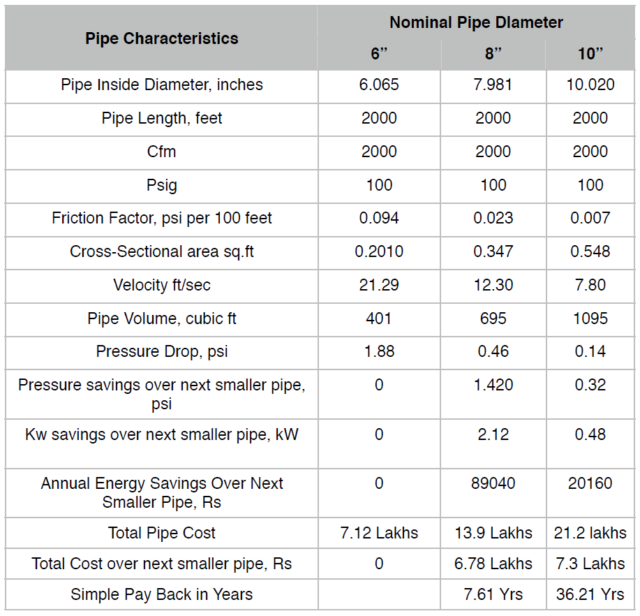Guide to design Energy Efficient Distribution / Piping System
The below article deals with the link between the demand side and the supply side and deals with how to get the treated compressed air to the points of use at the right rate of flow and at the right pressure. Pressure losses due to inadequate piping will result in increased energy costs and variations in the system pressure, with adverse effects on the production process.
How to Select Pipe Sizes?
The Compressor room header into which the air compressor discharges should be sized so that the air velocity within the header does not exceed 20 ft / sec, thus allowing for future expansion. Distribution header piping leaving the compressor room should be sized to allow an air velocity not to exceed 30 ft / sec to minimize pressure drop. The air from each compressor should not enter the header at 90 degrees to the header axis but at a 45 degree angle in the direction of flow and always through wide-radius elbows.
An air receiver located after a reciprocating air compressor can prevent pressure pulsations from affecting rotary or centrifugal compressors and their controls in the same system. To minimize pressure drop, distribution header piping leaving the compressor room should be sized to allow an air velocity not to exceed 30 ft/sec. The following equation, or the chart of pressure drop in piping in Fig 1, may be used to determine proper piping sizes:
Where:
A = Cross – Sectional area of the pipe bore, in2.
Q = Flow rate, ft3/min free air.
Pa = Prevailing atmospheric absolute pressure, psia.
Pd = Compressor discharge gauge pressure (or line pressure), psig.
V = Design pipe velocity, ft/sec.

Where:
A = Cross – Sectional area of the pipe bore, in2.
D = Pipe Bore diameter, in.

Example: Size a distribution pipe for 1,000 cfm free air with a compressor discharge pressure of 100 psig for a plant in Coimbatore, at an elevation of 1350 Metres above mean sea level, where the ambient pressure is 12.2 psia. Use a Maximum velocity of 30 ft/sec.

The nearest pipe size is 3 inches, which would increase the velocity in the pipes to 37 ft/ sec. This may be acceptable if the length of the pipe is not extensive. A 4-Inch Pipe would reduce the velocity to approximately 21 ft/sec and substantially reduce pressure loss.
Fig 1, Shows pressure loss in 1,000 feet of various pipe diameters, with an initial pressure of 100 psig, and also pressure loss through screw fittings. These losses demonstrate the need for adequate pipe sizes.

Example: calculating pressure drop.
What is the pressure drop in a 2-inch pipe, 350 feet in length, with an a initial pressure of 85 psig and a flow rate of 500 cfm of free air?
From Fig 1, pressure drop for 500 cfm in 1000 feet of 2 inch pipe = 19.2 psi.

This is considered excessive, so a 3-inch pipe would be recommended, making the calculation:
2.34 x 350 x (100 + 14.5) = 0.94 psi or 0.06 Bar.
Economic Considerations in Pipe Size Selection :
Pipe Sizing should be based on economic principles. Most Companies have a process or justification process for capital improvements over a certain amount.
Example: Pipe Size Selection
A New Production Plant was added to a Spinning Mill 2000 feet from the existing compressor room as part of their expansion plans. It was determined that the new plant will consume between an average of 2000 cfm. The Plant engineer has been tasked with purchasing and installing a 2000 ft connecting pipe. The plant engineer wants to determine what is the most economic pipe size for this project.

Using the velocity limit of distribution header piping of 30 ft/sec, this approximates to a 5 -inch diameter pipe, which is considered to be Non Standard. A 6-inch pipe is the smallest size to consider. Should a Larger pipe diameter should be used? The below table identifies a economic solution to the same.

How about Materials ?
Many Industrial plants use schedule 40 steel piping, with or without galvanizing, for 100 to 125 psig service. Many food, pharmaceutical, textile, and other plants that use oil-free compressors install either Stainless Steel Piping or Aluminum Piping to avoid potential corrosion problems and resulting downstream contamination. A Few factors that may be taken into consideration when choosing the piping materials are,
A. Note that the roughness of the internal bore will be a factor in the amount of pressure drop experienced. Drawn pipe and tubing have smoother surfaces and cause less friction.
B. Where Oil Free air is essential, stainless steel or Aluminum piping is recommended. These piping are also recommended for the system piping of all centrifugal and oil free reciprocating or rotary compressors.
C. Aluminum Piping provides good structural strength with light weight and high resistance to corrosion.
D. The Smooth surface of Aluminum or Stainless Steel tubing achieves a low coefficient of friction resulting in lower pressure losses at high rates of flow.
E. It is very important always to follow the manufacturerʼs instructions and recommended best practices when installing any piping system.
The Above article is part of the Best Practices Training Manual of Compressed Air Challenge.
Need help in the designing and commissioning of the system?
Please fill the details below & avail a free consultation with our Compressed Air Piping Specialist…
Regional Office
# 12 Sri Venkatalakshmi Nagar
Singanallur, Coimbatore – 641005
India


